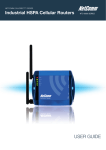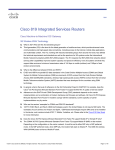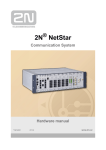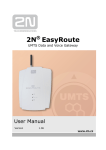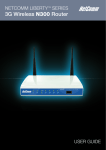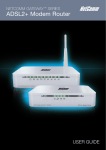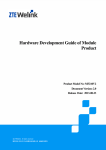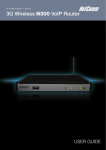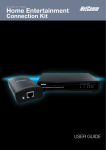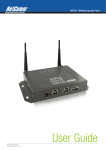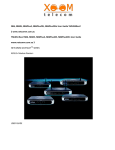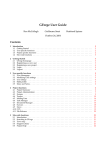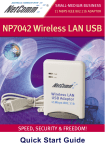Download USER GUIDE
Transcript
NETCOMM CALLDIRECT SERIES Industrial HSPA Ethernet Router NTC-5000 SERIES NTC-5908 NTC-5909 NTC-5900 USER GUIDE NetComm Commercial Preface This manual provides information relating to the installation, operation, and application of this device. The individual reading this manual is presumed to have a basic understanding of telecommunications terminology and concepts. If you find the product to be broken or malfunctioning, please contact technical support for immediate service by email at [email protected] For product updates, new product releases, manual revisions, or software upgrades, please visit our website at www.netcommlimited.com Important Safety Instructions With reference to unpacking, installation, use and maintenance of your electronic device, the following basic guidelines are recommended: D o not use or install this product near water to avoid fire or shock hazard. For example, near a bathtub, kitchen sink, laundry tub, or near a swimming pool. Also, do not expose the equipment to rain or damp areas (e.g. a wet basement). D o not connect the power supply cord on elevated surfaces. Allow it to lie freely. There should be no obstructions in its path and no heavy items should be placed on the cord. In addition, do not walk on, step on or mistreat the cord. To safeguard the equipment against overheating, make sure that all openings in the unit that offer exposure to air are unobstructed. WARNING • Disconnect the power line from the device before servicing. Copyright Copyright©2011 NetComm Limited. All rights reserved. The information contained herein is proprietary to NetComm Limited. No part of this document may be translated, transcribed, reproduced, in any form, or by any means without prior written consent of NetComm Limited NOTE: This document is subject to change without notice. Save Our Environment When this equipment has reached the end of its useful life, it must be taken to a recycling centre and processed separately from domestic waste. The cardboard box, the plastic contained in the packaging, and the parts that make up this router can be recycled in accordance with regionally established regulations. Never dispose of this electronic equipment along with your household waste. You may be subject to penalties or sanctions under the law. Instead, ask for disposal instructions from your municipal government. Please be responsible and protect our environment. This manual covers the following products: NetComm NTC-5908 NetComm NTC-5909 NetComm NTC-5900 NTC-5000 Series User Guide 2 YML5000 www.netcomm.com.au NetComm CallDirect Series - NTC-5000 Series Table of Contents Introduction������������������������������������������������������������������������������������������������������������������������������������������������������������������������������������������������5 1.1 Overview���������������������������������������������������������������������������������������������������������������������������������������������������������������������������������������������������������������������5 1.2 Features����������������������������������������������������������������������������������������������������������������������������������������������������������������������������������������������������������������������5 1.3 Hardware Overview�����������������������������������������������������������������������������������������������������������������������������������������������������������������������������������������������������6 Configuring your Router�����������������������������������������������������������������������������������������������������������������������������������������������������������������������������9 2.1 Inserting the SIM card�������������������������������������������������������������������������������������������������������������������������������������������������������������������������������������������������9 2.2 Setting up the cellular router����������������������������������������������������������������������������������������������������������������������������������������������������������������������������������������9 2.3 Preparing your computer�������������������������������������������������������������������������������������������������������������������������������������������������������������������������������������������10 2.4 Accessing your router’s configuration pages��������������������������������������������������������������������������������������������������������������������������������������������������������������10 2.5 Unlocking the SIM�����������������������������������������������������������������������������������������������������������������������������������������������������������������������������������������������������11 Band / Provider Selection������������������������������������������������������������������������������������������������������������������������������������������������������������������������15 3.1 Locking to a specific band����������������������������������������������������������������������������������������������������������������������������������������������������������������������������������������15 3.2 Choosing your provider manually������������������������������������������������������������������������������������������������������������������������������������������������������������������������������15 How to Establish a Connection to the Cellular Network������������������������������������������������������������������������������������������������������������������������17 4.1 Initiating a PPP Connection directly from the router���������������������������������������������������������������������������������������������������������������������������������������������������17 4.2 How to establish a connection using the router in transparent PPPoE mode�������������������������������������������������������������������������������������������������������������18 Ethernet Related Commands������������������������������������������������������������������������������������������������������������������������������������������������������������������20 5.1 How to configure the Ethernet IP address�����������������������������������������������������������������������������������������������������������������������������������������������������������������20 5.2 How to configure DNS Masquerading�����������������������������������������������������������������������������������������������������������������������������������������������������������������������20 5.3 How to configure the DHCP Server���������������������������������������������������������������������������������������������������������������������������������������������������������������������������20 5.4 How to configure your device’s IP address manually (no DHCP)��������������������������������������������������������������������������������������������������������������������������������21 Routing Configuration������������������������������������������������������������������������������������������������������������������������������������������������������������������������������23 6.1 Configuring Static Routes������������������������������������������������������������������������������������������������������������������������������������������������������������������������������������������23 6.2 How to configure RIP������������������������������������������������������������������������������������������������������������������������������������������������������������������������������������������������24 6.3 How to configure VRRP��������������������������������������������������������������������������������������������������������������������������������������������������������������������������������������������24 6.4 NAT configuration������������������������������������������������������������������������������������������������������������������������������������������������������������������������������������������������������25 Services Features�������������������������������������������������������������������������������������������������������������������������������������������������������������������������������������27 7.1 How to configure the dynamic DNS client�����������������������������������������������������������������������������������������������������������������������������������������������������������������27 7.2 How to configure NTP�����������������������������������������������������������������������������������������������������������������������������������������������������������������������������������������������27 7.3 How to configure the Periodic Ping Reset Monitor�����������������������������������������������������������������������������������������������������������������������������������������������������27 7.4 How to configure a Periodic Reset Timer�������������������������������������������������������������������������������������������������������������������������������������������������������������������28 System Features���������������������������������������������������������������������������������������������������������������������������������������������������������������������������������������30 8.1 Remote Administration����������������������������������������������������������������������������������������������������������������������������������������������������������������������������������������������30 8.2 To save a copy of the routers configuration���������������������������������������������������������������������������������������������������������������������������������������������������������������31 8.3 To restore a copy of the routers configuration������������������������������������������������������������������������������������������������������������������������������������������������������������31 8.4 To restore the router’s configuration to the factory defaults����������������������������������������������������������������������������������������������������������������������������������������31 8.5 To upgrade to a new router application version���������������������������������������������������������������������������������������������������������������������������������������������������������31 Troubleshooting����������������������������������������������������������������������������������������������������������������������������������������������������������������������������������������33 9.1 Viewing the system log����������������������������������������������������������������������������������������������������������������������������������������������������������������������������������������������33 9.2 Common problems and solutions.�����������������������������������������������������������������������������������������������������������������������������������������������������������������������������33 Specifications�������������������������������������������������������������������������������������������������������������������������������������������������������������������������������������������36 10.1 Hardware specifications������������������������������������������������������������������������������������������������������������������������������������������������������������������������������������������36 10.2 RJ-45 Ethernet port integration parameters������������������������������������������������������������������������������������������������������������������������������������������������������������36 Legal & Regulatory Information���������������������������������������������������������������������������������������������������������������������������������������������������������������38 YML5000 www.netcomm.com.au NTC-5000 User Guide 3 Introduction NetComm CallDirect Series - NTC-5000 Series Introduction Thank you for purchasing an Industrial HSPA Cellular Network Router from NetComm. This manual illustrates how to set-up and configure your router appropriately for your chosen task. The router is primarily managed and configured via a web browser. This manual will take you through the steps required to configure and use your unit correctly. 1.1 Overview An NTC-5000 series router allows you to build wide area networks utilising the superior speeds supported by 3G UMTS networks. Employing an embedded 3G modem module, the router offers downlink speeds of up to 7.2Mbps and uplink speeds of up to 5.76Mbps. The NTC-5000 series provides the user with a point-to-point or point-to-multi-point communications link in a single, compact and resilient unit. As a fully featured cellular router, it supports a large number of communication interfaces and protocols to meet the demands of today’s telemetry and WAN applications. Designed with remote installations in mind, the NTC-5000 series supports multi-level system monitoring giving the user peace of mind that the device will keep the lines of communication up and open. 1.2 Features Powerful industrial mobile broadband router platform supporting various networks and service types offering UMTS/HSPA and quad-band GSM/GPRS/EDGE network access E mbedded Sierra HSPA modem module MC8790V (NTC-5908) or MC8792V (NTC-5909) or MC8795V (NTC- 5900) with Qualcomm MSM6290 chipset Wide area data access speeds in 3G mode up to 7.2Mbps in downlink (HSDPA category 8) and up to 5.76Mbps in uplink (HSUPA category 6) Wide area data access speeds in 2G mode up to 236 kbps (EDGE multi slot class 12) Industrial features – rugged enclosure, wide operating temperature range -30°C to 70°C, wall mount option and locking DC power terminal block Wide input voltage range 8 – 28 V DC suitable for diverse environments and applications Web interface for easy centralized configuration and management from any PC One 10/100Base-TX port for Ethernet connections Supports SNMP with mobile broadband specific MIB, PPPoE, RIP, VRRP, DDNS, DHCP and DHCP Relay System monitoring, remote diagnostics and configuration over the air and a diagnostic log viewer via a web browser Supports NAT, Port forwarding and a DMZ host Configurable APN profiles, offers an APN drop-down list to make selecting the appropriate APN easier Supports manual network scan Recovery mode to restore router system software in the event of corruption YML5000 www.netcomm.com.au NTC-5000 User Guide 5 NetComm Commercial 1.3 Hardware Overview 1.3.1 Overview of indicator lights There are a total of five LED’s on the router, one red, one amber and three green. Listed below are the specifications of the LED’s and their corresponding colours. LED Display Description POWER (red) Solid ON The red Power LED indicates power is applied to the DC power input jack. Tx / Rx (amber) Solid ON The amber LED will light upon data being sent to or received from the DCD (green) Solid ON Service Type (green) The green LED will illuminate when cellular network coverage is detected. cellular network. RSSI (green) The green Data Carrier Detect LED illuminates to indicate a data connection. Solid ON 3G: Indicates UMTS/HSPA available coverage Flashing EDGE: Indicates EDGE available coverage Off 2G: Indicates GSM/GPRS available coverage only. This green LED shows Received Signal Strength. There are three possible states that the RSSI LED can operate in, based upon signal level. Solid ON Strong:Indicates the RSSI level is -86dbm Flashing once per second Medium: Indicates the RSSI level is -110dbm and -86dbm Off Poor: Indicates the RSSI level is less than -110dbm NTC-5000 Series User Guide 6 YML5000 www.netcomm.com.au NetComm CallDirect Series - NTC-5000 Series 1.3.2 Overview of the router Interfaces Main Antenna Socket 5 Indicator LEDs Ethernet Port Reset Button + - SIM Card Reader Locking Power Terminal Block Field Desciption Antenna Socket SMA 5 Indicator LEDs Indicates the connection strength, service type, data traffic, data carrier connection and network connection strength Locking Power Terminal Locking Power terminal block and the wide voltage range of 8-28V DC simplify the Block installation in different industrial environments Reset Button Resetting the router to factory default values Ethernet Port For direct connection to your devices through a hub or network router SIM Card Reader For insertion and removal of SIM card YML5000 www.netcomm.com.au NTC-5000 User Guide 7 Configure NetComm CallDirect Series - NTC-5000 Series Configuring your Router You will need the following hardware components to set up the router: Power supply (8-28VDC) Ethernet cable Laptop or PC Active SIM card 2.1 Inserting the SIM card Press the SIM ‘Eject’ button to eject SIM card bay. Make sure the SIM card is inserted correctly by inserting the SIM with the gold side facing down on the SIM card bay and in the direction as shown below: Press the SIM Eject button Insert SIM card 2.2 Setting up the cellular router Attach the supplied antenna to the router by screwing it onto the antenna connector. Connect the power adapter to the mains and plug the output into the power jack of the router. The red power LED on the panel should illuminate. +VE -VE Polarity of DC Power Plug (Screw Terminal) + - YML5000 www.netcomm.com.au NTC-5000 User Guide 9 NetComm Commercial 2.3 Preparing your computer Connect one end of the supplied Ethernet cable to the Ethernet port of your router. Connect the other end of the cable to the LAN port of your computer. Configure your PC’s Ethernet interface to use a dynamically assigned IP address by doing the following: Click on the Start button, then the Control Panel and then Network Connections. Right click on Local Area Connection and select Properties to open the configuration dialogue box of the Local Area Connection as below: Find and click Internet Protocol (TCP/IP) from the protocol list box and then click the Properties button. The TCP/IP configuration window will pop up as illustrated below. Under General tab, select the radio buttons ‘Obtain an IP address automatically’ and ‘Obtain DNS server address automatically’. Then press the OK button to close TCP/IP configuration window. Press the Close button to complete the computer preparation for the router. 2.4 Accessing your router’s configuration pages Furthermore, there are two system management accounts for maintaining the system, each of which has slightly different levels of management capabilities. The root manager account is empowered with full privileges while the admin manager (administrator) can manage all settings of the router except functions like Firmware Upgrade, Device Configuration Backup and Restore and Reset router to factory default. To login to the router in root manager mode, please use the following login details: http://192.168.1.1 USERNAME: root PASSWORD: admin To login to the router in admin manager mode, please use the following default login details. http://192.168.1.1 USERNAME: admin PASSWORD: admin NOTE – Whenever you make changes, please refresh your web page to prevent errors occurring due to caching. NTC-5000 Series User Guide 10 YML5000 www.netcomm.com.au NetComm CallDirect Series - NTC-5000 Series Below illustrates the steps required to access the router’s web browser configuration: 1. Open your web browser (e.g. Internet Explorer/Firefox/Safari) and navigate to http://192.168.1.1/ 2. Click Login and type “admin” (without quotes) in the Username and Password fields. Then click on Submit. 2.5 Unlocking the SIM If the SIM card is locked you will need to unlock it with a PIN provided with your SIM card. You can find out if the SIM is locked by viewing the SIM Status on the Status page: If the SIM Status is SIM locked as above, you should be automatically redirected to the SIM unlock page. If not, then do the following: Click on the “Internet Settings” menu followed by “WWAN (3G)“ and then “SIM Security”: When you click on the ‘SIM Security’ menu item you should see the following message:- Click OK Next, enter the PIN code and confirm the PIN code. Then click Save. YML5000 www.netcomm.com.au NTC-5000 User Guide 11 NetComm Commercial Now Click on the link and the Home Status page should look as below with SIM Status ‘SIM OK’: 2.5.1 Enter PUK If after three incorrect attempts at entering the PIN code, you are requested to enter a PUK code: You will need to contact your carrier to obtain this number. Your carrier will issue you a PUK code to enable you to unlock the SIM and enter a new PIN code. Enter the new PIN and PUK codes, click Save. If you have entered the PUK correctly you should see the following message: NTC-5000 Series User Guide 12 YML5000 www.netcomm.com.au NetComm CallDirect Series - NTC-5000 Series Now click on the ”Status” menu item at the top left-hand side of the page. It should reflect the screenshot below and show a SIM Status of ‘SIM OK’: 2.5.2 The ‘Remember PIN’ feature This feature allows the router to automatically send the PIN to the SIM each time the SIM asks for it (usually at power up). This enables the SIM to be PIN Locked (to prevent unauthorised re-use of the SIM elsewhere), while still allowing the router to connect to the cellular service. When this feature is enabled, the PIN entered by the user when they set the “Remember PIN” feature is encrypted and stored locally in the router. The next time the SIM asks the router for the PIN, the router decrypts the PIN and automatically sends it to the SIM without user intervention. When this feature is disabled and the SIM is PIN locked, the user must manually enter the PIN via the router‘s configuration interface. This is clearly not desirable where the router is unattended. YML5000 www.netcomm.com.au NTC-5000 User Guide 13 Band / Provider Selection NetComm CallDirect Series - NTC-5000 Series Band / Provider Selection 3.1 Locking to a specific band You may want to lock the router to a specific band. To do this, click on the “Internet Settings” menu followed by “WWAN (3G)“ and then the “Band / Provider” menu item on the right.. You may want to do this if you’re using the router in a country with multi frequency networks that may not all support HSPA. You can select the router to only connect on the network frequencies that suit your requirements. Make your selection from the “Change Band:” drop down list. The following band settings options are applicable. BAND SELECTION OPTIONS - NTC-5908 UMTS 850MHZ ONLY = UMTS 850 MHZ ONLY WCDMA ALL = UMTS 850/2100/1900MHZ UMTS 850MHZ, 2G = UMTS 850 MHZ GSM/EDGE/GPRS 900/1800/1900MHZ 2G = GSM/EDGE/GPRS 900/1800/1900MHZ ALL BANDS (AUTOBAND) = UMTS 850/2100/1900MHZ GSM/EDGE/GPRS 850/900/1800/1900MHZ BAND SELECTION OPTIONS - NTC-5909 UMTS 900MHZ ONLY = UMTS 900 MHZ ONLY WCDMA ALL = UMTS 900/2100/1900MHZ UMTS 900MHZ, 2G = UMTS 900 MHZ GSM/EDGE/GPRS 850/900/1800/1900MHZ 2G = GSM/EDGE/GPRS 850/900/1800/1900MHZ ALL BANDS (AUTOBAND) = UMTS 850/900/2100/1900MHZ GSM/EDGE/GPRS 850/900/1800/1900MHZ Click “Save” to confirm your new band settings. NOTE: After changing the band, if the change is not reflected on the frequency field on the “Status” page then you may need to reboot the unit. 3.2 Choosing your provider manually The default setting is “Automatic”. To scan manually for available cellular network operators (providers) follow the following steps: If you are currently connected to the internet, disconnect your session and ensure “Auto Connect” is disabled in the current cellular connection profile you are using (You can check this by clicking on the “Internet Settings” menu followed by “WWAN (3G)“ and then the “Connection” menu item on the right). Select the operator mode “Manual” Click on the “Scan” button. A list of cellular operators in the vicinity of your router should appear below. Select your chosen provider from the list of detected operators and click the “Apply” button. The router will then use the chosen operator to attempt to connect to the cellular service profile you have elected to use. YML5000 www.netcomm.com.au NTC-5000 User Guide 15 Connection NetComm CallDirect Series - NTC-5000 Series How to Establish a Connection to the Cellular Network This section describes how to set up the router to initiate a WWAN connection. There are 2 different ways to set up a WWAN connection via PPP: Initiating the PPP Connection directly from the router (most common). Initiating the PPP Connection from a different PPP client (i.e. laptop or router) with the router running in transparent PPPoE mode. 4.1 Initiating a PPP Connection directly from the router The Status page of the router should be displayed as below. Please ensure that the SIM Status is ‘SIM OK’ before you initiate a WWAN connection. Click on the “Internet Settings” menu followed by “WWAN (3G)“ and then the “Connection” menu item on the right. 4.1.1 To connect using a connection profile The router supports multiple APN profiles; these profiles allow you to configure the settings that the router will use to connect to the cellular network. First examine the list of configured profiles. Select the profile that you wish to connect with and make sure that the APN name field is correct. This is very important. Select “Enable” for the Auto Connect option and click “Save”. From now on, Auto Connect will remain enabled and the router will automatically connect unless you come back to this page and disable it. YML5000 www.netcomm.com.au NTC-5000 User Guide 17 NetComm Commercial 4.1.2 To confirm successful connection Now click on the link to return to the status page. Please pay close attention to WWAN section on the page. The WWAN Status should be ‘up’. The Local field shows the current IP address that the network has allocated for the router. Congratulations. Your new router is now ready to use! 4.2How to establish a connection using the router in transparent PPPoE mode To enable PPPoE mode, firstly ensure “Auto Connect” is disabled in all profiles on the “Connection” configuration page by clicking on the “Internet Settings” menu followed by “WWAN (3G)“ and then the “Connection” menu item on the right and then select each connection profile and disable the Auto Connect option and save the updated settings. Select “Enable” to enable PPPoE Specify the APN you wish to use to suit your carrier In addition you may specify an optional “Service Name”. When a “Service Name” is specified the connected device must use the same service name when connecting. This facility is particularly useful if you have more than one PPPoE router or modem on a single Ethernet network. Finally click “Save” to save your settings and enable PPPoE. NTC-5000 Series User Guide 18 YML5000 www.netcomm.com.au Ethernet Related Commands NetComm Commercial Ethernet Related Commands 5.1 How to configure the Ethernet IP address This facility is available by clicking on the “Internet Settings” menu followed by “LAN“ and then the “IP Setup” menu item on the right. The default IP of the Ethernet port is 192.168.1.1 with subnet mask 255.255.255.0. If you wish to change this then simply enter the new IP address and click on the ”Save” button at the bottom of the page. Since the IP address has changed you will have to re-enter the new IP address configured in your browser to access the configuration pages. 5.2 How to configure DNS Masquerading DNS masquerading allows the router to forward DNS requests to dynamically assigned DNS servers. Clients on the router’s LAN can then use the router as a DNS server without needing to know of the dynamically assigned DNS servers assigned by the cellular network. This facility is available by clicking on the “Internet Settings” menu followed by “LAN“ and then the “IP Setup” menu item on the right. There should be no need to disable this feature in most cases, however, if you need to do so simply select “Disable” and click ”Save”. 5.3 How to configure the DHCP Server Use the following procedure to change the router’s DHCP server default settings. Ensure your PC’s Ethernet connector is configured to automatically obtain an IP and DNS server address. This facility is available by clicking on the “Internet Settings” menu followed by “LAN“ and then the “DHCP” menu item on the right. When you plug in the Ethernet cable to your PC, the router should automatically assign it an IP address within 10-15 seconds. Please be aware that you will be sharing the bandwidth of the router between all connected devices. You can manually set DNS1 and DNS2 or if DNS Masquerade is enabled the DHCP DNS1 address will automatically be set to the router’s LAN address. This example has a start address of 100, an end address of 199, lease time of 86,400 seconds, and uses the DNS servers that are autoassigned by the network upon connection. If you do not enter the DNS1 and DNS2 addresses manually, then to browse the Internet from your Ethernet connected device you must enable DNS Masquerade (see above). Upon enabling DNS Masquerade, you will notice that the DNS1 address is automatically set to the IP address of the Ethernet port. DNS addresses are then automatically assigned by the connection to the network. NTC-5000 Series User Guide 20 YML5000 www.netcomm.com.au NetComm CallDirect Series - NTC-5000 Series 5.3.1 How to configure static DHCP assignments This facility is available by clicking on the “Internet Settings” menu followed by “LAN“ and then the “DHCP” menu item on the right. You may assign a particular IP address to a specific device every time that device makes a DHCP request as follows: Click “Add” Enter a name for the computer or device Enter the computer or devices’ MAC address Enter the IP address to assign Click “Save” 5.4 How to configure your device’s IP address manually (no DHCP) If your device has a static IP address set, you can configure your device to work with the router by manually configuring your device to the following settings: Set your device’s IP address to any valid IP between 192.168.1.2 and 192.168.1.99 or disable the DHCP server and use any address. Do not use the IP address assigned to the router’s Ethernet interface. Set your device’s subnet to: 255.255.255.0. Set your Gateway to the IP address of the router’s Ethernet interface: 192.168.1.1 DNS (if required) set to 192.168.1.1 or manually set to your carrier’s DNS Servers. YML5000 www.netcomm.com.au NTC-5000 User Guide 21 Router Configuration NetComm CallDirect Series - NTC-5000 Series Routing Configuration 6.1 Configuring Static Routes This facility is available by clicking on the “Internet Settings” menu followed by “Routing” and then the “Static” menu item on the right. Some routes are added by default by the router on initialisation such as the Ethernet subnet route for routing to a device on the Ethernet subnet. A PPP route is also added upon obtaining a WAN PPP connection. However, if you have other routers (hence networks) on the Ethernet subnet for example, you may want to add some more static routes. 7.1.2 Adding Static Routes Enter the values in the fields as above Click ”ADD” NOTE: You must increment the “Route no” by 1 for each route in the “Route no” field otherwise that route will be overwritten. The Active Routing table at the bottom will show the new route added as shown below: Example: If you have another router on the Ethernet side of the router with a gateway of 192.168.1.5 that interfaces to network 10.123.0.0/16 and you want to get to a device on that network then you enter: 10.123.0.0 in the Destination IP address field 255.255.0.0 in the IP Subnet Mask Field 192.168.1.5 in the Gateway IP address Field The lower the metric value the higher the priority this routes has over other routes. 7.1.3 Deleting Static Routes Click on the “Delete Entry” text (in blue) for the route as shown above. The route will be deleted immediately. YML5000 www.netcomm.com.au NTC-5000 User Guide 23 NetComm Commercial 6.2 How to configure RIP Routing Information Protocol (RIP) is used for advertising routes to other routers. Thus all the routes in the router’s routing table will be advertised to other nearby routers. For example, the route for the router’s Ethernet subnet could be advertised to a router on the PPP interface side so that a router on this network will know how to route to a device on the router’s Ethernet subnet. You will have to add the routes appropriately in the Static Routes section – see Adding Static Routes. NOTE – it is possible that some routers will ignore RIP. To enable RIP click on the “Internet Settings” menu followed by “Routing“ and then the “RIP” menu item on the right. Click “Enable” on the RIP Page Select RIP version Click ”Save RIP” 6.3 How to configure VRRP Virtual Router Redundancy Protocol (VRRP) is a non-proprietary redundancy protocol designed to increase the availability of the default gateway servicing hosts on the same subnet. This increased reliability is achieved by advertising a “virtual router” (an abstract representation of master and backup routers acting as a group) as a default gateway to the host(s) instead of one physical router. Two or more physical routers are then configured to stand for the virtual router, with only one doing the actual routing at any given time. If the current physical router that is routing the data on behalf of the virtual router fails, an arrangement is made for another physical router to automatically replace it. The physical router that is currently forwarding data on behalf of the virtual router is called the master router. Master routers have a priority of 255 and backup router(s) can have priority between 1-254. A virtual router must use 00-00-5E-00-01-XX as its MAC address. The last byte of the address (XX) is the Virtual Router Identifier (VRID), which is different for each virtual router in the network. This address is used by only one physical router at a time, and is the only way that other physical routers can identify the master router within a virtual router. To enable VRRP click on the “Internet Settings” menu followed by “Routing“ and then the “VRRP” menu item on the right. Click “Enable” to activate VRRP Enter a Virtual Device ID – this is the VRRP ID which is different for each virtual router on the network. Enter a Router Priority – a higher value is a higher priority. Enter the Virtual IP address – this is the VRRP IP address that both virtual routers share. Click ”SAVE VRRP” NOTE: Configuring VRRP changes the MAC address of the Ethernet port and therefore if you want to resume with the web configuration you must use the new IP address (VRRP IP) or on a command prompt type: arp –d <ip address> (i.e arp –d 192.168.1.1) to clear the arp cache.(old MAC address). NTC-5000 Series User Guide 24 YML5000 www.netcomm.com.au NetComm CallDirect Series - NTC-5000 Series 6.4 NAT configuration This facility is available by clicking on the “Internet Settings” menu followed by “Routing“ and then the “NAT” menu item on the right. The router is in NAT mode by default. 6.4.1 How to configure Port Forwarding This is only needed if you need to map inbound requests to a specific port on the WAN IP address to a device connected on the Ethernet interface, e.g. a web camera. Enter the information as appropriate Click “Save” <MAPPING NO> 1 TO AS MANY AS NEEDED. <PROTOCOL> TCP, UDP, ALL PROTOCOLS <SOURCE IP> SPECIFIES EITHER A “FRIENDLY” IP ADDRESS THAT IS ALLOWED TO ACCESS THE ROUTER OR A WILDCARD IP ADDRESS OF 0.0.0.0 THAT ALLOWS ALL IP ADDRESSES TO ACCESS THE ROUTER. <INCOMING PORT RANGE> EXTERNAL PORT(S) TO LISTEN TO. <DESTINATION IP> LOCAL AREA NETWORK ADDRESS OF DEVICE TO FORWARD INBOUND REQUESTS TO. <DESTINATION PORT RANGE> LOCAL AREA NETWORK PORT(S) TO FORWARD CONNECTIONS TO. Example: NOTE:If the “Incoming Port Range” specifies a single port (as above) then the destination port can be set to any port. If the “Incoming Port Range” specifies a range of port numbers then the “Destination Port Range” MUST be the same as the “Incoming Port Range”. Configured mappings are displayed as follows: To delete an entry click on the “Delete Entry” link from the list of IP Mappings. 6.4.2 How to configure DMZ The Demilitarised Zone (DMZ) enables a device to utilise a direct connection to the WAN. This means any incoming connections are forwarded directly to the specified device. YML5000 www.netcomm.com.au NTC-5000 User Guide 25 Services Features NetComm CallDirect Series - NTC-5000 Series Services Features 7.1 How to configure the dynamic DNS client This facility is available by clicking on the “Services” menu followed by the “DDNS” menu item on the right. Dynamic DNS provides a method for the router to update an external name server with the current WAN IP address. To configure dynamic DNS: Click “Enable”. Select the Dynamic DNS service that you wish to use. Enter your dynamic DNS account credentials. Click “Save”. 7.2 How to configure NTP This facility is available by clicking on the “Services” menu followed by the “NTP” menu item on the right. The NTP (Network Time Protocol) settings allow your router to synchronise its internal clock with a global Internet Time server. This setting will affect functions such as System Log entries and Firewall settings. 7.3 How to configure the Periodic Ping Reset Monitor This facility is available by clicking on the “Services” menu followed by the “System Monitor” menu item on the right. The Periodic Ping Reset Monitor configures the router to transmit controlled ping packets to 1 or 2 user specified IP addresses. Should the router not receive responses to the pings the router will reboot. This works as follows: A. After every “Periodic Ping Timer” configured interval, the router sends 3 consecutive pings to the “Destination Address”. B. If all 3 pings fail the router sends 3 consecutive pings to the “Second Address”. C. The router then sends 3 consecutive pings to the “Destination Address” and 3 consecutive pings to the “Second Address” every “Periodic Ping Accelerated Timer” configured interval. D. If all accelerated pings in step C above fail the number of times configured in “Fail Count”, the router reboots. E. If any ping succeeds the router returns to step A and does not reboot. NOTE: The “Periodic Ping Timer” should never be set to a value less than 60 seconds; this is to allow the router time to reconnect to the cellular network following a reboot. YML5000 www.netcomm.com.au NTC-5000 User Guide 27 NetComm Commercial Periodic Ping Disabled To disable the Periodic Ping Reset Monitor simply set to “Fail Count” 0. Periodic Ping Enabled An Example Setup: The setup below will ping 10.1.2.3 every 10 minutes, if it fails it then tries to ping 10.1.2.4, if that also fails it then accelerates the ping attempts to once every 60 seconds and if 3 successive ping attempts at the one minute interval fails, the router will reboot. NOTE: The traffic generated by the periodic ping feature is counted as chargeable usage, please keep this in mind when selecting how often to ping. 7.4 How to configure a Periodic Reset Timer This facility is available by clicking on the “Services” menu followed by the “System Monitor” menu item on the right.. The router can be configured to automatically reboot after a periodic interval specified in minutes. While this is not necessary, it does ensure that in the case of remote installations, it will reboot the router if some anomaly occurs. The default value is 0 which disables the Periodic Reset Timer. The maximum value is 65535 minutes. NTC-5000 Series User Guide 28 YML5000 www.netcomm.com.au System Features NetComm Commercial System Features 8.1 Remote Administration This facility is available by clicking on the “System” menu followed by “Administration“. Remote administration is an optional feature which allows an administrator to connect to the router’s web user interface via the Internet to check the current status or to perform configuration changes on the router. When enabled and once a cellular broadband connection is established, simply enter the WWAN Local IP address (as shown on the Status page) into the address bar of your web browser and login as normal when prompted. The port number and passwords required to access the web user interface can be changed depending on your requirements. To change the password, select the username whose password you would like to change and then enter the new password in both the “Password” and “Confirm Password” fields and then click Save. Please note: It is not necessary to change the password if you only wish to change the port in use. Simply leave the password fields blank. The IP address below is an example only, yours will be different. http://10.10.10.10:8080 Username admin Password admin NTC-5000 Series User Guide 30 YML5000 www.netcomm.com.au NetComm CallDirect Series - NTC-5000 Series 8.2 To save a copy of the routers configuration To get access to this facility, firstly login to the router in root manager mode. Please use the following login details: The status page of the router will then display. http://192.168.1.1 Username: root Password: admin NOTE: To perform functions like Firmware Upgrade, Device Configuration Backup and to Restore and Reset router to factory defaults, you need to login in the root manager mode. Click on the “System” menu followed by “Load / Save“ and then the “Settings” menu item on the right.. Key in the root manager Password and click Save This will download a copy of the current settings from the router to your PC. NOTE: • It is NOT possible to edit the contents of the file downloaded; if you modify the contents of the configuration file in any way you will not be able to restore it later. • You may change the name of the file if you wish but the filename extension must remain “.cfg” 8.3 To restore a copy of the routers configuration This facility is available by clicking on the “System” menu followed by “Load / Save“ and then the “Settings” menu item on the right. Click “Browse”. Select the configuration file you wish to restore Click “Restore” 8.4 To restore the router’s configuration to the factory defaults This facility is available by clicking on the “System” menu followed by “Load / Save“ and then the “Settings” menu item on the right. Click “Restore” to restore the factory default configuration. 8.5 To upgrade to a new router application version This facility is available by clicking on the “System” menu followed by “Load / Save“ and then the “Upload” menu item on the right. Click on the ”Browse” button and browse to where the upgrade file is located on your PC/laptop Click “Upload” to upload NTC-5000 series router firmware YML5000 www.netcomm.com.au NTC-5000 User Guide 31 Troubleshooting NetComm CallDirect Series - NTC-5000 Series Troubleshooting 9.1Viewing the system log This facility is available by clicking on the “System” menu followed by “Log“. The System Log enables you to troubleshoot any issues you may be experiencing with your router. Selecting the appropriate logging level will show you either informational messages about your router or all the way up to every message produced when “All” is selected. 9.2 Common problems and solutions. 9.2.1 I cannot seem to access the web page interface The default IP address of the router is 192.168.1.1, so first try to open a web browser to this address. Also check that your laptop/PC is on the same subnet as the router’s Ethernet port if you are using a static IP address. 9.2.2 The router was connected but cannot get back online. You may need to enable the periodic ping timer using the System Monitor (Click on the “Services” menu followed by “System Monitor”). This ensures that if the connection drops (i.e. outage on the network), that the router will reboot after so many failed pings and then force a re-connect. Setting the timer to around 15 mins should be sufficient. NOTE: The traffic generated by the periodic ping feature is counted as chargeable usage, please keep this in mind when selecting how often to ping. 9.2.3 The router is rebooting frequently Check the “System Monitor” configuration and see if the ”Force reset every” option is set to something other than 0. If it is set to 1 this means the unit will reboot every minute regardless of what happens. Reset it to 0 if you don’t want this feature or something quite large if you don’t want the router to reboot so often. 9.2.4 The router has a connection but cannot access the Internet Check that DNS Masquerade is enabled by clicking on the “Internet Settings” menu followed by “LAN“ and then the “IP Setup” menu item on the right. Then click on the “Internet Settings” menu followed by “LAN“ and then the “DHCP” menu item on the right. In the section “DHCP Configuration”, make sure that the DHCP DNS Server address 1 IP address is set to the same address as that of the Ethernet port IP Address). YML5000 www.netcomm.com.au NTC-5000 User Guide 33 NetComm Commercial 9.2.5 I cannot seem to get a cellular WAN connection Click on the “Internet Settings” menu followed by “WWAN (3G)“ and then the “Connection” menu item on the right and check that the APN is correct. Also check that the username and password credentials are correct if the APN in use requires these. Make sure that Auto Connect is enabled. 9.2.6 I have set the Band but now it does not show the correct Frequency on the Status page and I cannot get a connection If this happens you must reboot the router. 9.2.7 The SIM status indicates “SIM removed” on the status page If a SIM was installed correctly this may indicate that the SIM has been removed or inserted whilst the unit is powered up. In this case you must reboot the unit. To reboot the router, click on the “System” menu followed by “Reboot“. Clicking the Reboot button on this page will reboot the router. NTC-5000 Series User Guide 34 YML5000 www.netcomm.com.au Specifications NetComm Commercial Specifications 10.1 Hardware specifications NTC-5908 NTC-5909 NTC-5900 MCU / Processor Atmel AT91SAM9G20 Microcontroller / ARM9 based RAM 32MB DRAM Memory 8MB NAND Flash Wireless WAN Interface Sierra Wireless MC8790V Chipset Qualcomm MSM6290 3G UMTS Bands 850/ 1900/ 2100 MHz 2G GSM Bands 850/ 900/ 1800/ 1900 MHz Peak Data Speed HSDPA Category 8 – Downlink up to 7.2 Mbps HSUPA Release 6 – Uplink up to 5.76 Mbps EDGE Multi Slot Class 12 – Downlink/Uplink up to 236 kbps SIM Card Reader Locking Tray for USIM/SIM in Mini-SIM card format (25.00 x 15.00 x 0.76 mm) Antenna Interface 1x SMA (female), 50 Ohm Network Interface Fast Ethernet 10/100Base-TX RJ-45 port with Auto MDI/MDIX LED Indicators 5x LEDs: Power, Service, Tx/Rx, DCD, RSSI Power Input Captive DECA® Euro Type Terminal Block MC100#50802 (DC Plug with Screw Terminal) Input Voltage Range 8 - 28 VDC Power Consumption Idle: 1.32W (110 mA @ 12 V DC) Sierra Wireless MC8792V Sierra Wireless MC8795V 900/ 1900/ 2100 MHz 850/ 900/ 1900/ 2100 MHz Active HSUPA connection: 3.6W (300 mA @ 12 V DC) Maximum: 6.72W (560 mA @ 12 V DC) Dimensions 127 x 103 x 29 mm Weight 235g Temperature / Humidity Operating: -30°C ~ 70°C (-22 ~ 140 F) / 0 ~ 85% (non-condensing) Storage: -55°C ~ 85°C (-67 ~ 185 F) / Regulatory Compliancy A-Tick, RoHS 10.2 RJ-45 Ethernet port integration parameters You can use the guide below to design Ethernet cables to integrate the router into your systems. Below you will find pin outs of the RJ-45 Ethernet plug and jack connectors: Pin Function Color 1 TX + White/Orange 2 TX - Orange/White 3 RX + White/Green 4 Blue/White 5 6 White/Blue RX - Green/White 7 White/Brown 8 Brown/White NOTE: The Ethernet port on the router supports Auto MDI/MDIX, you may use a straight through or cross-over Ethernet cable. NTC-5000 Series User Guide 36 YML5000 www.netcomm.com.au Appendix NetComm Commercial Legal & Regulatory Information This manual is copyright. Apart from any fair dealing for the purposes of private study, research, criticism or review, as permitted under the Copyright Act, no part may be reproduced, stored in a retrieval system or transmitted in any form, by any means, be it electronic, mechanical, recording or otherwise, without the prior written permission of NetComm Limited. NetComm Limited accepts no liability or responsibility, for consequences arising from the use of this product. NetComm Limited reserves the right to change the specifications and operating details of this product without notice. Trademarks NetComm, NetComm CallDirect™ and NetComm logo are registered trademarks of NetComm Limited. Sierra Wireless is a trademark of Sierra Wireless. Windows® is a registered trademark of Microsoft Corporation. All other trademarks are acknowledged the property of their respective owners. GNU General Public License This product includes software code that is subject to the GNU General Public License (“GPL”) or GNU Lesser General Public License (“LGPL”). This code is subject to the copyrights of one or more authors and is distributed without any warranty. A copy of this software can be obtained by contacting NetComm Limited on +61 2 9424 2059. Customer Information ACA (Australian Communications Authority) requires you to be aware of the following information and warnings: (1) This unit shall be connected to the Telecommunication Network through a line cord which meets the requirements of the ACA TS008 Standard. (2) This equipment has been tested and found to comply with the Standards for C-Tick and or A-Tick as set by the ACA. These standards are designed to provide reasonable protection against harmful interference in a residential installation. This equipment generates, uses, and can radiate radio noise and, if not installed and used in accordance with the instructions detailed within this manual, may cause interference to radio communications. However, there is no guarantee that interference will not occur with the installation of this product in your home or office. If this equipment does cause some degree of interference to radio or television reception, which can be determined by turning the equipment off and on, we encourage the user to try to correct the interference by one or more of the following measures: • Change the direction or relocate the receiving antenna. • Increase the separation between this equipment and the receiver. • Connect the equipment to an alternate power outlet on a different power circuit from that to which the receiver/TV is connected. • Consult an experienced radio/TV technician for help. (3) The power supply that is provided with this unit is only intended for use with this product. Do not use this power supply with any other product or do not use any other power supply that is not approved for use with this product by NetComm. Failure to do so may cause damage to this product, fire or result in personal injury. NTC-5000 Series User Guide 38 YML5000 www.netcomm.com.au NetComm CallDirect Series - NTC-5000 Series Product Warranty NetComm NTC-5000 series products have a standard 12 months warranty from date of purchase. The warranty is granted on the following conditions: 1. This warranty extends to the original purchaser (you) and is not transferable; 2. This warranty shall not apply to software programs, batteries, power supplies, cables or other accessories supplied in or with the product; 3. The customer complies with all of the terms of any relevant agreement with NetComm and any other reasonable requirements of NetComm including producing such evidence of purchase as NetComm may require; 4. The cost of transporting product to and from NetComm’s nominated premises is your responsibility; and, 5. NetComm does not have any liability or responsibility under this warranty where any cost, loss, injury or damage of any kind, whether direct, indirect, consequential, incidental or otherwise arises out of events beyond NetComm’s reasonable control. This includes but is not limited to: acts of God, war, riot, embargoes, acts of civil or military authorities, fire, floods, electricity outages, lightning, power surges, or shortages of materials or labour. 6. The customer is responsible for the security of their computer and network at all times. Security features may be disabled within the factory default settings. NetComm recommends that you enable these features to enhance your security. The warranty is automatically voided if: 1. You, or someone else, use the product, or attempts to use it, other than as specified by NetComm; 2. The fault or defect in your product is the result of a voltage surge subjected to the product either by the way of power supply or communication line, whether caused by thunderstorm activity or any other cause(s); 3. The fault is the result of accidental damage or damage in transit, including but not limited to liquid spillage; 4. Your product has been used for any purposes other than that for which it is sold, or in any way other than in strict accordance with the user manual supplied; 5. Your product has been repaired or modified or attempted to be repaired or modified, other than by a qualified person at a service centre authorised by NetComm; and, 6. The serial number has been defaced or altered in any way or if the serial number plate has been removed. Limitations of Warranty The Trade Practices Act 1974 and corresponding State and Territory Fair Trading Acts or legalisation of another Government (“the relevant acts”) in certain circumstances imply mandatory conditions and warranties which cannot be excluded. This warranty is in addition to and not in replacement for such conditions and warranties. To the extent permitted by the Relevant Acts, in relation to your product and any other materials provided with the product (“the Goods”) the liability of NetComm under the Relevant Acts is limited at the option of NetComm to: • Replacement of the Goods; or • Repair of the Goods; or • Payment of the cost of replacing the Goods; or • Payment of the cost of having the Goods repaired. All NetComm ACN 002 490 486 products have a standard 12 months warranty from date of purchase. However some products have an extended warranty option (refer to packaging). To be eligible for the extended warranty you must supply the requested warranty information to NetComm within 30 days of the original purchase by registering on-line via the NetComm web site at www.netcomm.com.au YML5000 www.netcomm.com.au NTC-5000 User Guide 39 NetComm Commercial NETCOMM LIMITED Head Office PO Box 1200, Lane Cove NSW 2066 Australia P: (02) 9424 2070 F: 1800 063 962 E: [email protected] W: www.netcom-commercial.com. DYNALINK NZ 12c Tea Kea Place, Albany, Auckland, New Zealand P: 09 448 5548 F: 09 448 5549 E: [email protected] W: www.dynalink.co.nz Product Warranty NetComm products have a standard 12 months warranty from date of purchase. However some products have an extended warranty option, via registering your product online at the NetComm website www.netcomm.com.au Technical Support If you have any technical difficulties with your product, please refer to the support section of our website. www.netcomm-commercial.com.au/support NOTE:NetComm Technical Support for this product only covers the basic installation and features outlined in the Quick Start Guide. For further information regarding the advanced features of this product, please refer to the configuring sections in the User Guide or contact a Network Specialist. Trademarks and registered trademarks are the property of NetComm Limited or their respective owners. Specifications are subject to change without notice. Images shown may vary slightly from the actual product. NTC-5000 Series User Guide 40 YML5000 www.netcomm.com.au








































